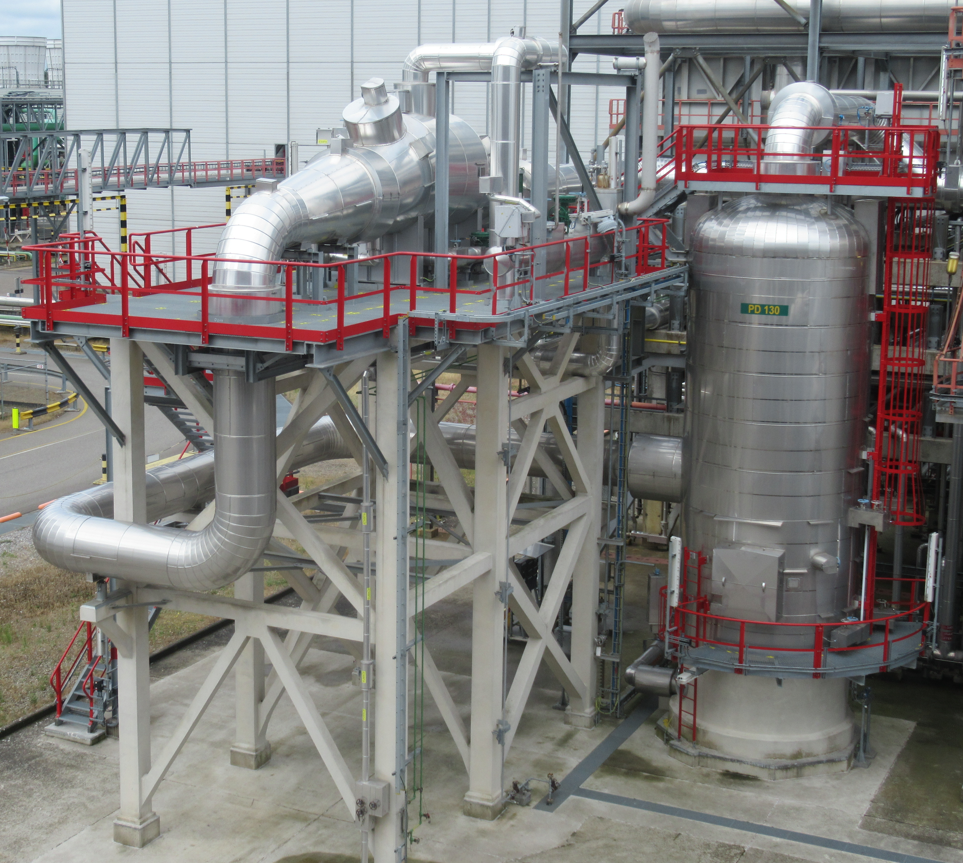Installing extra heat exchangers
Heat exchanger networks play a vital role in enhancing energy efficiency, transferring heat between different process streams within a manufacturing plant. For example, moving heat from hot process streams to cold ones improves energy efficiency by reusing heat that would otherwise be wasted; maintaining optimal temperatures for processes ensures that reactions and operations occur under the best conditions; and by recovering and reusing heat, they reduce the need for additional heating or cooling, leading to significant energy savings.
A detailed engineering review of the heat integration network by the team in Geel revealed that excess energy could be recovered better by installing extra heat exchangers and rearranging the network configuration. This significantly reduced natural gas consumption, and CO2 emissions by over 13,000 tons per annum.
Increasing steam generation
One of the extra heat exchangers was a steam generator that transformed excess process heat into steam. Since the start-up of the new network, it became clear that this steam generator could do more than it was designed for.
Condensate is the liquid formed from condensed steam or vapour, the condensate pump moves it from one place to another, meaning the energy it contains can be re-used and water can be conserved. The impeller is a rotating part that transfers energy from the motor to the fluid, causing it to move through the pump. While the condensate feed valve regulates the flow of the condensate into the feedwater system that supplies water to the boilers.
The team made two relatively small but significant changes, increasing the size of both the valve and pump impeller. This enables more steam to be produced at the same production rates. Some of the steam is used in our paraxylene (PX) unit at the site, the remainder is lower CO2 emission steam that replaces the use of boiler steam at our PTA unit.
Improving steam efficiency
The Outside Battery Limits, or OSBL, host supporting facilities and infrastructure that provide essential services to plants like ours. In our Geel site, that includes boilers that generate steam used for various purposes within the plant, such as heating, power generation, and driving equipment. The boilers use natural gas as a fuel source, generating heat from the combustion process to convert water into steam. Under a project, our Geel team replaced boiler steam with process steam created from the residual heat of the PTA unit production. Which reduced the use of natural gas, and CO2 emissions by 1,700 tons per year.
Reducing freshwater use
Our PTA plant in Geel has a water stream containing acetic acid and heavy organics that is normally sent to the waste treatment to remove pollutants before the wastewater is discharged into the environment. The Geel team is instead redirecting ~30 ton/h of this waste stream to its distillation tower. Distillation towers separate mixtures of liquids such as chemical compounds into their individual components based on their boiling points – in this case, the tower is used to separate the water from the organics. The water is then reused in the process, replacing the use of fresh, high purity demineralized water (or ‘demin water’) that ensures the quality of the final product. The acetic acid and heavy organics are also reused in the oxidation reactor, a critical part of the PTA manufacturing process.
This method enables the team to produce high quality end products while reducing the use of fresh water and additional materials.
ISO 50001 certification
Since 2018, our Geel site has achieved ISO 50001 certification. ISO 50001 is an internationally recognized standard for successful energy management. It helps organizations implement structured frameworks to understand their baseline energy use and establish targets, plans and performance measures to reduce energy consumption.
- It provides a framework for organizations to optimize their energy performance, leading to reduced energy consumption and costs
- This leads to significant greenhouse gas emission reductions
- Helps organizations ensure they are meeting legal and regulatory requirements related to energy management
- Ensures organizations continuously improve their operational practices and energy management
Achieving ISO 50001 certification is a major undertaking that includes: developing an energy policy; putting an energy team in place; developing an energy management system that includes procedures, processes and performance indicators; continuous tracking and improvement; and internal audits. Accredited certification bodies conduct external audits and verify compliance with ISO 50001.
The consistent achievement of the standard demonstrates the Geel site’s commitment to constantly improving its energy management standards and performance.

